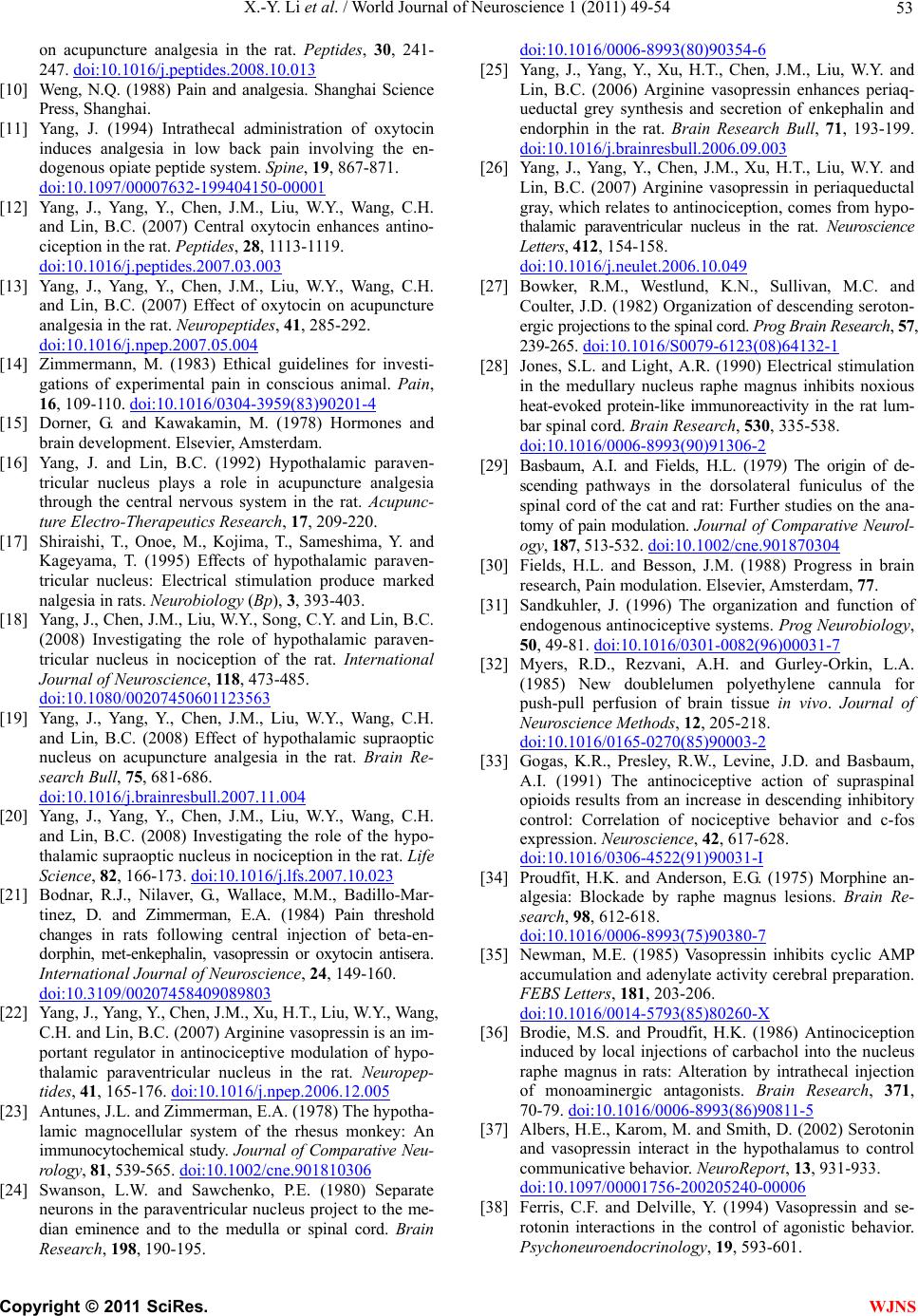
X.-Y. Li et al. / World Journal of Neuroscience 1 (2011) 49-54 53
on acupuncture analgesia in the rat. Peptides, 30, 241-
247. doi:10.1016/j.peptides.2008.10.013
[10] Weng, N.Q. (1988) Pain and analgesia. Shanghai Science
Press, Shanghai.
[11] Yang, J. (1994) Intrathecal administration of oxytocin
induces analgesia in low back pain involving the en-
dogenous opiate peptide system. Spine, 19, 867-871.
doi:10.1097/00007632-199404150-00001
[12] Yang, J., Yang, Y., Chen, J.M., Liu, W.Y., Wang, C.H.
and Lin, B.C. (2007) Central oxytocin enhances antino-
ciception in the rat. Peptides, 28, 1113-1119.
doi:10.1016/j.peptides.2007.03.003
[13] Yang, J., Yang, Y., Chen, J.M., Liu, W.Y., Wang, C.H.
and Lin, B.C. (2007) Effect of oxytocin on acupuncture
analgesia in the rat. Neuropeptides, 41, 285-292.
doi:10.1016/j.npep.2007.05.004
[14] Zimmermann, M. (1983) Ethical guidelines for investi-
gations of experimental pain in conscious animal. Pain,
16, 109-110. doi:10.1016/0304-3959(83)90201-4
[15] Dorner, G. and Kawakamin, M. (1978) Hormones and
brain development. Elsevier, Amsterdam.
[16] Yang, J. and Lin, B.C. (1992) Hypothalamic paraven-
tricular nucleus plays a role in acupuncture analgesia
through the central nervous system in the rat. Acupunc-
ture Electro-Therapeutics Research, 17, 209-220.
[17] Shiraishi, T., Onoe, M., Kojima, T., Sameshima, Y. and
Kageyama, T. (1995) Effects of hypothalamic paraven-
tricular nucleus: Electrical stimulation produce marked
nalgesia in rats. Neurobiology (Bp), 3, 393-403.
[18] Yang, J., Chen, J.M., Liu, W.Y., Song, C.Y. and Lin, B.C.
(2008) Investigating the role of hypothalamic paraven-
tricular nucleus in nociception of the rat. International
Journal of Neuroscience, 118, 473-485.
doi:10.1080/00207450601123563
[19] Yang, J., Yang, Y., Chen, J.M., Liu, W.Y., Wang, C.H.
and Lin, B.C. (2008) Effect of hypothalamic supraoptic
nucleus on acupuncture analgesia in the rat. Brain Re-
search Bull, 75, 681-686.
doi:10.1016/j.brainresbull.2007.11.004
[20] Yang, J., Yang, Y., Chen, J.M., Liu, W.Y., Wang, C.H.
and Lin, B.C. (2008) Investigating the role of the hypo-
thalamic supraoptic nucleus in nociception in the rat. Life
Science, 82, 166-173. doi:10.1016/j.lfs.2007.10.023
[21] Bodnar, R.J., Nilaver, G., Wallace, M.M., Badillo-Mar-
tinez, D. and Zimmerman, E.A. (1984) Pain threshold
changes in rats following central injection of beta-en-
dorphin, met-enkephalin, vasopressin or oxytocin antisera.
International Journal of Neuroscience, 24, 149-160.
doi:10.3109/00207458409089803
[22] Yang, J., Yang, Y., Chen, J.M., Xu, H.T., Liu, W.Y., Wang,
C.H. and Lin, B.C. (2007) Arginine vasopressin is an im-
portant regulator in antinociceptive modulation of hypo-
thalamic paraventricular nucleus in the rat. Neuropep-
tides, 41, 165-176. doi:10.1016/j.npep.2006.12.005
[23] Antunes, J.L. and Zimmerman, E.A. (1978) The hypotha-
lamic magnocellular system of the rhesus monkey: An
immunocytochemical study. Journal of Comparative Neu-
rology, 81, 539-565. doi:10.1002/cne.901810306
[24] Swanson, L.W. and Sawchenko, P.E. (1980) Separate
neurons in the paraventricular nucleus project to the me-
dian eminence and to the medulla or spinal cord. Brain
Research, 198, 190-195.
doi:10.1016/0006-8993(80)90354-6
[25] Yang, J., Yang, Y., Xu, H.T., Chen, J.M., Liu, W.Y. and
Lin, B.C. (2006) Arginine vasopressin enhances periaq-
ueductal grey synthesis and secretion of enkephalin and
endorphin in the rat. Brain Research Bull, 71, 193-199.
doi:10.1016/j.brainresbull.2006.09.003
[26] Yang, J., Yang, Y., Chen, J.M., Xu, H.T., Liu, W.Y. and
Lin, B.C. (2007) Arginine vasopressin in periaqueductal
gray, which relates to antinociception, comes from hypo-
thalamic paraventricular nucleus in the rat. Neur oscience
Letters, 412, 154-158.
doi:10.1016/j.neulet.2006.10.049
[27] Bowker, R.M., Westlund, K.N., Sullivan, M.C. and
Coulter, J.D. (1982) Organization of descending seroton-
ergic projections to the spinal cord. Prog Brain Res earch, 57,
239-265. doi:10.1016/S0079-6123(08)64132-1
[28] Jones, S.L. and Light, A.R. (1990) Electrical stimulation
in the medullary nucleus raphe magnus inhibits noxious
heat-evoked protein-like immunoreactivity in the rat lum-
bar spinal cord. Brain Research, 530, 335-538.
doi:10.1016/0006-8993(90)91306-2
[29] Basbaum, A.I. and Fields, H.L. (1979) The origin of de-
scending pathways in the dorsolateral funiculus of the
spinal cord of the cat and rat: Further studies on the ana-
tomy of pain modulation. Journal of Comparative Neurol-
ogy, 187, 513-532. doi:10.1002/cne.901870304
[30] Fields, H.L. and Besson, J.M. (1988) Progress in brain
research, Pain modulation. Elsevier, Amsterdam, 77.
[31] Sandkuhler, J. (1996) The organization and function of
endogenous antinociceptive systems. Prog Neurobiology,
50, 49-81. doi:10.1016/0301-0082(96)00031-7
[32] Myers, R.D., Rezvani, A.H. and Gurley-Orkin, L.A.
(1985) New doublelumen polyethylene cannula for
push-pull perfusion of brain tissue in vivo. Journal of
Neuroscience Methods, 12, 205-218.
doi:10.1016/0165-0270(85)90003-2
[33] Gogas, K.R., Presley, R.W., Levine, J.D. and Basbaum,
A.I. (1991) The antinociceptive action of supraspinal
opioids results from an increase in descending inhibitory
control: Correlation of nociceptive behavior and c-fos
expression. Neuroscience, 42, 617-628.
doi:10.1016/0306-4522(91)90031-I
[34] Proudfit, H.K. and Anderson, E.G. (1975) Morphine an-
algesia: Blockade by raphe magnus lesions. Brain Re-
search, 98, 612-618.
doi:10.1016/0006-8993(75)90380-7
[35] Newman, M.E. (1985) Vasopressin inhibits cyclic AMP
accumulation and adenylate activity cerebral preparation.
FEBS Letters, 181, 203-206.
doi:10.1016/0014-5793(85)80260-X
[36] Brodie, M.S. and Proudfit, H.K. (1986) Antinociception
induced by local injections of carbachol into the nucleus
raphe magnus in rats: Alteration by intrathecal injection
of monoaminergic antagonists. Brain Research, 371,
70-79. doi:10.1016/0006-8993(86)90811-5
[37] Albers, H.E., Karom, M. and Smith, D. (2002) Serotonin
and vasopressin interact in the hypothalamus to control
communicative behavior. NeuroReport, 13, 931-933.
doi:10.1097/00001756-200205240-00006
[38] Ferris, C.F. and Delville, Y. (1994) Vasopressin and se-
rotonin interactions in the control of agonistic behavior.
Psychoneuroendocrinology, 19, 593-601.
C
opyright © 2011 SciRes. WJNS